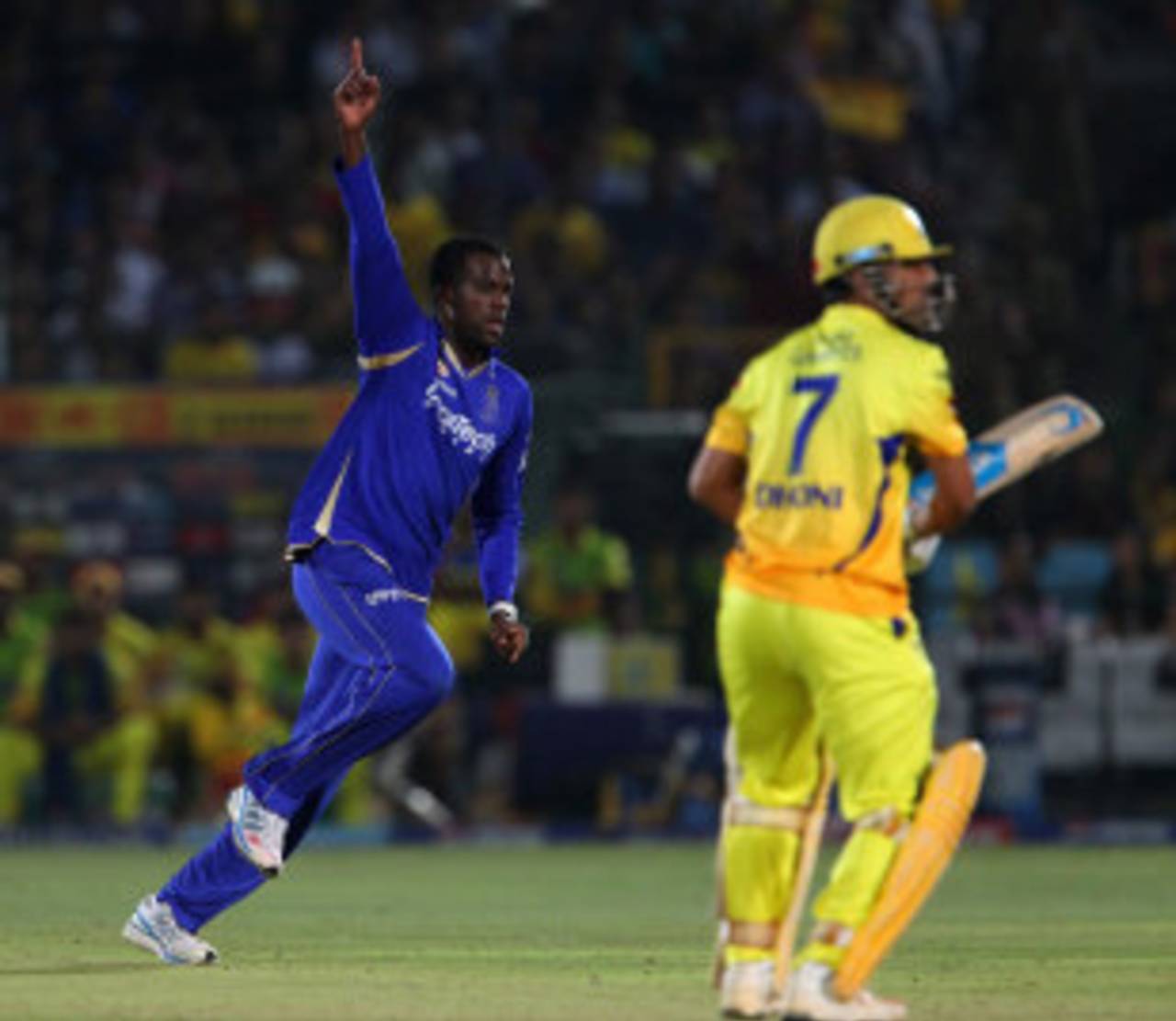For all the flashy hitting involved, Twenty20 remains a largely pessimistic sport. Morne Morkel doesn't get the first over at Delhi Daredevils, Rajasthan Royals protect
Shane Watson from the new ball on a testing pitch, at Kings XI Punjab David Miller has often been left batting with lesser batsmen, MS Dhoni doesn't want to come in to bat if there are more than 10 overs remaining, and Mumbai Indians' misuse of Kieron Pollard is now well documented. They are all better cricketers than that.
Captaining India, Dhoni once made the bold move of playing just six specialist batsmen - which should on paper be enough in a 20-over game - and immediately countered it by sending Irfan Pathan to
open the innings. He gave himself that extended warranty of a batsman at No. 7, but that No. 7 sat and saw Irfan eat up 30 crucial deliveries for just 31 runs.
You feared Rajasthan Royals were doing just that in their final home game of the season.
Chasing 142, they were tested by some good seam bowling at the top. Ajinkya Rahane fell to it, and you moved a little towards the edge of your seat to see how Watson would cope with it. Out came James Faulkner. The pinch-hitting experiment failed soon, you leaned forward again, but you saw Sanju Samson coming out. In a crucial chase, when you want your best batsman to face as many balls as possible, Watson was not to be seen until the third wicket fell. It was a good thing these three batsmen got out early and didn't waste too many deliveries, but the asking rate had already crossed eight. Soon it would nudge 10 an over.
Rahul Dravid, the captain in this instance, will tell you it was all tactics. And Dravid is no defensive captain. There is no way he would have sent in a lesser batsman to face the best bowling in a Test match, a nightwatchman being the only exception. "It was a kind of wicket where we knew we needed to backend our batting," Dravid said. "And the fact that they had a couple of spinners we needed to target. I wouldn't say we got the batting order wrong.
"We didn't play the first 10 overs particularly well. I would have liked a few more runs in the first 10. Forty-nine for four isn't good enough, but we are lucky we had someone like Watson there in the end and Stuart Binny as well."
A stunning assault from Watson and Binny, a period of five overs that went for 81, brought Royals a comfortable win in the end. And as Dravid had planned, a spinner - R Ashwin, the best in India - was successfully targeted. However, Royals are a bit of an exception: they don't have the best of batting resources, and need insurance towards the end. Royal Challengers Bangalore don't have similar concerns with Chris Gayle because they have Virat Kohli and AB de Villiers following him.
That allowance made, you still wonder if Watson is not good enough a batsman to have played proper cricket against the better of Chennai Super Kings' quicks. Wasn't leaving all the eggs in Watson's basket a risk in itself? Why doesn't Dhoni, one of the best chasers in ODI cricket, bat early with Dwayne Bravo, S Badrinath, plus Albie Morkel at times, to follow him? In the
match that Miller won Kings XI Punjab with a crazy hundred, his third fifty-plus score in a row, he came in to bat in the 10th over.
The only plausible explanation for it is, you want your best batsmen to play with a mind that is not muddled with building an innings and pondering the consequences. It's not the number in the order that matters, but the number of overs remaining when they come in to bat. Somewhere deep inside, they want to take out the fear of being bowled out. That's 10 wickets in 20 overs. To think of that is pessimistic. It messes around with normal cricket.
In a bottom-line world, the success and failure of a strategy is determined by the ultimate result. It obviously worked tonight with Dravid holding Watson back. It failed when Dhoni opened with Irfan to have a cover for a cover. It failed when Kings XI had Manan Vohra and David Hussey batting ahead of a clearly in-form Miller who was left almost stranded against
Mumbai Indians.
It's a young sport still. We can't fully know the dynamics of these decisions because the pressures on the field are different. The captains are pondering these things as they go. Until then, just the thought that there can be a variant of cricket where you don't want to give your best cricketers to play the most part in the game is fascinating enough. After all these games aren't quite played on the sticky dogs that once made Don Bradman invert his batting order.
